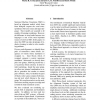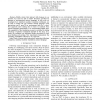228 search results - page 13 / 46 » Explanation-based Learning for Machine Translation |
LREC
2008
13 years 11 months ago
2008
Statistical Machine Translation (SMT) is based on alignment models which learn from bilingual corpora the word correspondences between source and target language. These models are...
LREC
2008
13 years 11 months ago
2008
Producing machine translation (MT) for the many minority languages in the world is a serious challenge. Minority languages typically have few resources for building MT systems. Fo...
NAACL
2007
13 years 11 months ago
2007
We propose three new features for MT evaluation: source-sentence constrained n-gram precision, source-sentence reordering metrics, and discriminative unigram precision, as well as...
HRI
2010
ACM
14 years 4 months ago
2010
ACM
—Mobile robots that interact with humans in an intuitive way must be able to follow directions provided by humans in unconstrained natural language. In this work we investigate h...
ACL
2001
13 years 11 months ago
2001
A good decoding algorithm is critical to the success of any statistical machine translation system. The decoder's job is to find the translation that is most likely according...


